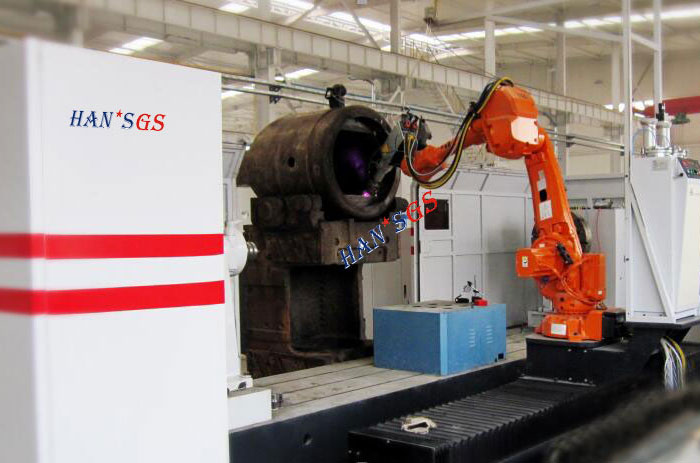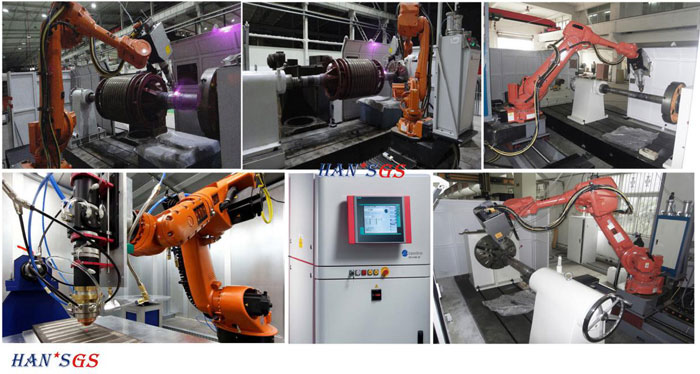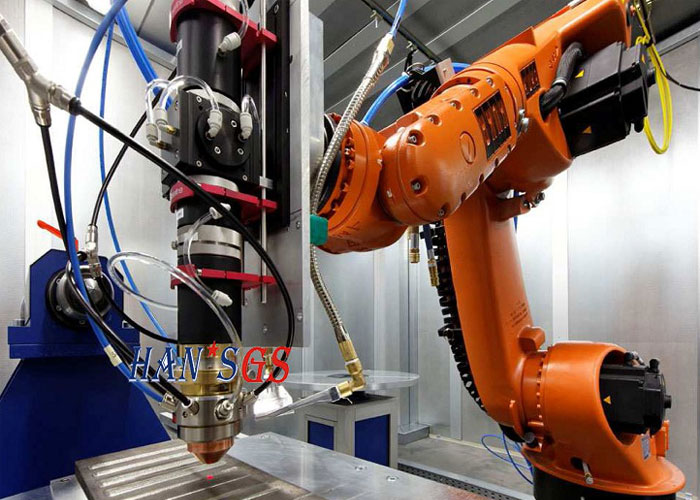Today is an era of rapid development of science and technology, the
traditional technology gradually become modern technology, robot from
science fiction went to the real life, the industrial field for the
earliest concept proposed for robot with servo technology to control the
robot joints, the robot action is taught by the operator, the robot can
achieve the action in accordance with the requirements of operation.
This is the current so-called teaching operation. This kind of control
is used almost all of today's robots. The flexible mechanical arm can
act according to the operator's request at will. It can also perform
remote control, pre programmed and other automatic control functions
when it can replace human hands. Industrial robots are widely used in
the field of laser cladding.
Principle, characteristics and mode of HANS GS laser cladding equipment
Laser
cladding is used as additive in different coating materials are placed
on the surface of the substrate cladding object selection, and then by
the laser irradiation and a thin layer on the substrate surface and
melting and rapid solidification formed after dilution is very low, the
surface metallurgical bonding of the coating and the substrate, so as to
achieve significantly improved resistance the corrosion and wear
resistance, high temperature resistance, oxidation resistance and
electrical characteristics of the part process on the surface of the
base.

The
purpose of the surface modification or repair of the workpiece is to
meet the requirements of the specific properties of the surface of the
material, and to save the unnecessary consumption of a large number of
valuable elements. Current use of laser cladding, which is mainly
applied to several aspects of material surface modification, such as gas
turbine blades, roller, roller, gear and so on, in order to increase
its performance; surface repair products, such as rotor, drill,
according to statistics the repair costs to reset the price 1/5. But
also shorten the maintenance time, solve the key components to solve
large enterprises of complete sets of major equipment continuous and
reliable operation of rapid repair problems; also by laser cladding
technology in mold surface covered with a layer of super abrasion and
corrosion resistant alloy, can greatly improve the service life.
At
present, the widely used laser cladding materials are as follows: nickel
base, cobalt base, iron base alloy, tungsten carbide composite and so
on. Among them, nickel based materials are used most, and they are
cheaper than cobalt based materials. Compared with the traditional
technology of surfacing, electroplating, spraying and gas phase
deposition, laser cladding has the following advantages.

(1)
the cooling rate is fast and the process of rapid solidification makes
the workpiece easy to obtain the new phase, such as non steady state and
amorphous state, which can not be obtained by the fine crystal
structure or the equilibrium state.
(2)
the coating dilution rate is low, which is combined with the
metallurgical bonding or interface diffusion of the processed parts. By
adjusting the parameters of the laser process power, spot size and focal
length, a good coating can be obtained, and the composition and
dilution are controllable.
(3)
the heat distortion is smaller, and the deformation can be controlled
and reduced to the assembly tolerance of the parts when the high power
density rapid cladding is used.
(4)
powder selection hardly requires any restrictions. It can be applied to
any kind of powder material according to process requirements,
especially for melting alloy with high melting point on the surface of
low melting point metal.
(5) the selection of area cladding can reduce the consumption of materials and improve the ratio of performance and price.
(6)
the laser beam can clad the unapproachable region, which is mainly to
ensure that the spot and powder can be irradiated to the area.
(7) the thickness range of the cladding layer is large and can be repeated and repeated cladding to the same part.
The main parameters of HANS GS laser
cladding are laser power, laser spot diameter, speed of cladding, spot
defocus, powder feeding speed, scanning speed, preheating temperature
and so on. These parameters have great influence on the dilution rate of
the cladding layer, the surface roughness, the crack and the
compactness of the cladding parts. It is a very complicated process that
each parameter affects each other and matches each other. Therefore, a
reasonable control method must be adopted to control these parameters in
the permitted range of laser cladding process. At the same time, the
repair work is a non - standard action, which is different from the
batch product on the production line. The location of damage is mostly
random, even often wear the same site between only a few products, and
many parts of the surface is not straight or curved regularly, which
requires the processing head in a cladding action according to
requirements in many different attitude to work, a multi axis machine
tool it is difficult to achieve, is usually carried out using manual
operation manual processing head, at the same time as mentioned before,
but also in a timely manner according to the matching process parameters
adjustment, the techniques and operator proficiency and concentration
requirements will be very high.



 中文
中文 English
English France
France العربية
العربية русский
русский español
español português
português srpski језик
srpski језик Việt Nam
Việt Nam
 中文
中文 English
English France
France العربية
العربية русский
русский español
español português
português srpski језик
srpski језик Việt Nam
Việt Nam







